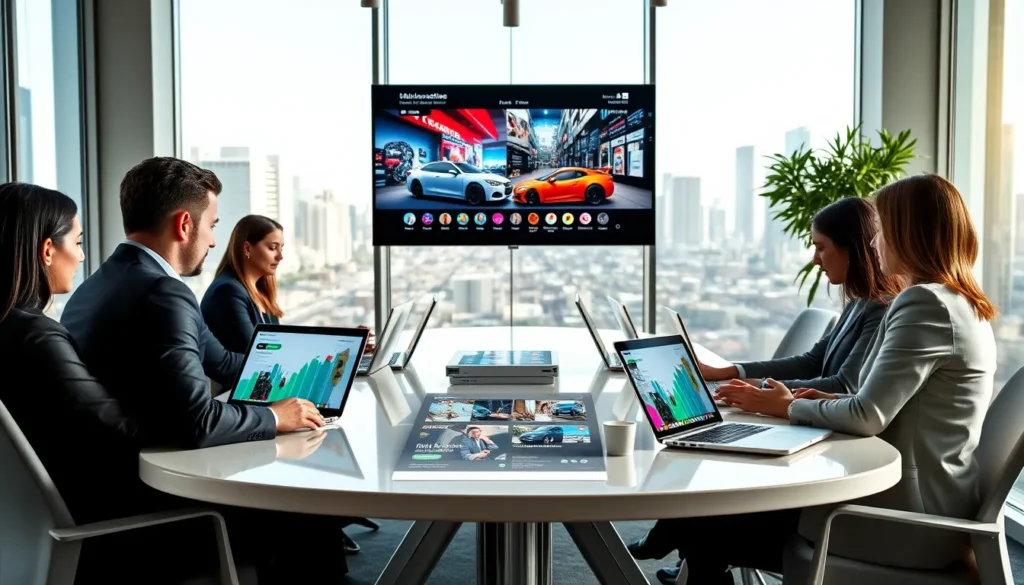Table of Contents
ToggleIn today’s fast-paced digital world, automotive social media marketing isn’t just an option: it’s a must. Think about it: everyone and their grandma is scrolling through social platforms, hunting for the next best deal on a shiny new car or the latest automotive news. So, what are you waiting for? If your dealership isn’t making waves in this space, it’s time to step on the gas and accelerate your marketing efforts. But don’t worry. This guide isn’t filled with jargon, just practical tips and insights to help your automotive business rev up its online presence. Buckle up, we’re about to take a thrilling ride through the ins and outs of social media marketing in the automotive world.
Understanding Automotive Social Media Marketing

Automotive social media marketing involves the tactics and strategies automotive businesses use to connect with consumers through various social media platforms. It’s not just about posting pretty pictures of cars: it’s about building relationships, creating conversations, and understanding what drives customer decisions. Social media allows brands to engage directly with their audience, offering a unique opportunity to showcase their vehicles, provide valuable content, and respond to customer inquiries in real time. The success of automotive social media marketing hinges on blending creativity with data-driven strategies, ensuring that each post resonates with potential buyers.
Also, in a landscape where consumer preferences shift faster than a car can change gears, staying relevant through social platforms is crucial. Businesses must adapt their approach based on trends, customer feedback, and industry changes. This flexibility makes social media a powerful tool for automotive brands aiming to foster customer loyalty and increase brand recognition.
The Importance of Social Media in the Automotive Industry
The automotive industry has witnessed a seismic shift with the advent of social media. It has transformed how consumers research, evaluate, and purchase vehicles. According to recent studies, up to 70% of consumers start their car-buying journey online, often influenced by social media interactions. Cars are no longer just mechanical marvels: they are lifestyle statements. Social media platforms create a space where brands can convey their personality and values, directly influencing consumer perceptions.
Also, social media allows for targeted advertising that reaches specific demographics interested in particular vehicle types, enhancing the chances of conversion. Engagement is another significant factor: a mere tweet or Instagram story can turn a passive viewer into an excited buyer. With platforms allowing for rich media formats, such as videos and live streams, automotive brands can showcase their products in ways traditional advertising simply cannot match. The importance of social media extends beyond just marketing, it drives brand loyalty and shapes customer experiences.
Key Platforms for Automotive Marketing
Not all social media platforms are created equal, especially within the automotive sector. Each platform caters to unique target audiences and content types. Here are some of the key players:
With its vast user base, Facebook remains a cornerstone for automotive marketing. Dealerships can create community pages, share customer testimonials, and even host events. Targeted ads allow brands to reach potential customers based on their interests.
For automotive marketing teams keen on visual storytelling, Instagram is gold. High-impact images, reels, and stories showcasing vehicles in action attract engagement like nothing else. Brands can use features like polls and questions to interact with their audience, driving higher interaction rates.
This platform is perfect for real-time engagement and customer service. Brands can respond to inquiries instantly, share news, or post updates on ongoing promotions. Utilizing trending hashtags can also help increase visibility during major auto shows or launches.
While primarily a professional network, LinkedIn is invaluable for B2B automotive marketing, particularly for manufacturers and suppliers. Connecting with other businesses and sharing industry insights can bolster brand authority.
YouTube
With the rise of video consumption, YouTube has become the go-to platform for showcasing vehicles. From walkthroughs to reviews, brands can leverage video content to educate and entice potential customers.
Creating an Effective Social Media Strategy
Crafting an effective social media strategy requires careful planning and execution. First and foremost, identify the target audience. Knowing who the potential buyers are can dictate content strategies, ensuring that communications resonate with the desired demographic.
Next, brands should set clear objectives. Whether it’s boosting brand awareness, generating leads, or increasing sales, defining goals will guide content creation and campaign strategies. Consistency in posting is also key: a well-maintained content calendar keeps followers engaged and informed.
The type of content shared is crucial as well. A balanced mix of promotional, informative, and entertaining posts can keep the audience engaged. Utilizing analytics tools to monitor which posts perform best can provide invaluable insights, enabling continuous improvement of the strategy.
Eventually, engagement should be a two-way street. Encouraging discussions, responding to comments, and acknowledging user-generated content fosters a community around the brand. This creates a loyal following that views the brand as an integral part of their automotive journey.
Types of Content That Drive Engagement
Engagement on social media doesn’t happen by chance. Certain types of content inherently attract more interaction. Here are some effective content ideas for automotive brands:
Visual Content
Striking images or videos showcasing vehicles make for excellent engagement. Consider behind-the-scenes footage from photo shoots or design processes as well.
User-Generated Content
Encouraging customers to share their own stories or testimonials about their vehicles not only showcases authenticity but fosters connection. Consider hashtags for customers to use when posting.
How-To Guides
Education is essential, especially for first-time buyers. Posts that explain features, maintenance tips, or comparisons between models can help guide purchasing decisions.
Polls and Q&A
Interactive content, such as polls about customer preferences or Q&A sessions, encourages followers to engage directly with the brand. This not only garners insights but also makes the brand feel more accessible.
Measuring Success in Automotive Social Media Marketing
Success in automotive social media marketing isn’t just about likes and followers. Quantitative metrics like engagement rates, reach, and conversions provide deeper insight into campaign performance. Analytics tools can track how many users engage with posts, how long they spend interacting with content, and what paths lead them to the website.
Also, brands should pay attention to qualitative metrics, customer comments and feedback can reveal sentiments toward the brand and products. A positive sentiment could indicate successful marketing efforts, while negative comments may highlight areas needing improvement.
Setting Key Performance Indicators (KPIs) before launching campaigns helps in assessing social media strategy effectiveness. KPIs might include increasing web traffic, generating inquiries, or boosting sales during a specific campaign period.
Future Trends in Automotive Social Media Marketing
The landscape of automotive social media marketing continues to evolve, paving the way for exciting opportunities. One significant trend is the rise of influencer marketing. Influencers in the automotive realm can generate authentic promotion through their enthusiastic reviews and personal experiences, reaching audiences who trust their recommendations.
Besides, the use of Augmented Reality (AR) in social media is on the rise. AR allows customers to visualize vehicles in real-world settings, enhancing the online shopping experience. Imagine a potential buyer using their phone to see how a car would look in their driveway.
Finally, video content will likely remain at the forefront. Short-form videos, such as TikTok and Instagram Reels, offer brands a unique way to showcase vehicles, attract attention, and increase engagement in less than a minute. As technology advances, being at the forefront of these trends ensures that automotive brands remain relevant in an increasingly competitive landscape.





